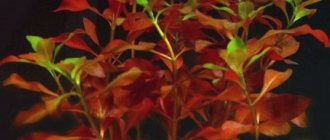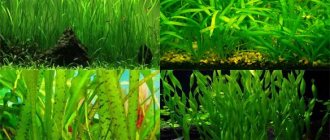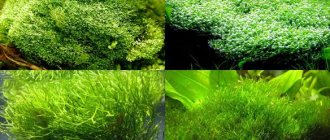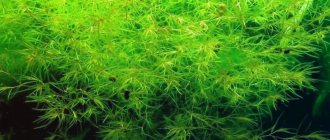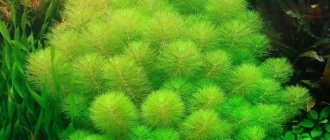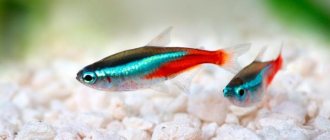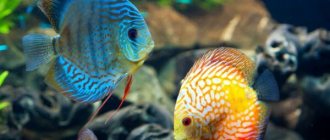Sagittária, or otherwise arrow leaf, is a whole genus of plants from the family Chastukhova. These plants can be found naturally in fresh water bodies of North America.
Neat bright green leaves in the form of a bush, relative unpretentiousness in maintenance, and easy propagation make saggitaria a very attractive plant for aquarists.
Among the aquarium species of saggitaria, the most common are the arrowhead (Sagittaria subulata), the dwarf arrowhead (Sagittaria spec) and the broadleaf arrowhead (Sagittaria platyphylla). The main difference is the width and length of the leaves. The dwarf is the smallest, its leaves have a very decorative size of up to 10cm, the broadleaf is slightly more than 20-40cm, and is also distinguished by its large leaf width. The tallest plant is saggitaria subulate; under good conditions it can reach from 30 to 50 cm in an aquarium; its leaves are narrow and sometimes their length has to be shortened.
Sagittaria in the aquarium and nature
Plants of the genus Arrowhead are mainly distributed in America, where about 30 varieties have been found. In Russia, this figure is much more modest - only three species. And in Africa and Australia, sagittaria was not found at all. Arrow leaf can grow in water, on the banks of reservoirs, in shallow water, in places with a muddy bottom.
Different types of sagittaria are grown especially for home aquariums. They differ in size, but have similar care needs (good lighting, clean water and a well-populated aquarium).
Broadleaf arrowhead (Sagittaria platyphylla)
This species is also known as spreading arrowhead. It can be grown in both an aquarium and a terrarium. Its peculiarity is that it feels better when grown above water. Representatives of this species are distinguished by large leaves up to 25 cm long. It likes to grow without neighbors. In its natural environment, it can be seen in swamps and slow-moving rivers in Central America. Forms underwater or surface leaves. The leaf blades have an elongated lanceolate shape and a sharp narrowing towards the tip. The leaf width is about 4 cm. It prefers a water temperature of no lower than 20 and no higher than 28 degrees. Responds well to annual feeding. It reproduces with the help of tendrils that form in the upper layers of the soil and grow from root rosettes.
What does sagittarium look like?
The genus unites perennial plants, which are characterized by:
- short, tuberous or knotty, well-developed white rhizomes;
- in underwater forms, the leaves are braid-shaped or petiolate with a small heart-shaped or elliptical plate floating on the surface of the water;
- Amphibian forms have leaves of three categories:
under water - braid-like without petioles, on the surface - floating, with petioles, with a plate in the shape of an egg, heart or arrow, above water - with a strong petiole, in the form of an arrow or spear; - all the foliage is bright green, juicy, fleshy, with a clearly defined vein in the middle.
- flowers with wide white petals and small green sepals are collected in racemose inflorescences on stalks rising above the water.
We can say that Sagittaria is similar to Vallisneria, but it is more powerful, and the leaves are shorter, wider and more curved.
Useful lifehacks
So that you do not have problems growing this crop, we bring to your attention the advice of experienced aquarists:
- Aquarium sagittaria on sale are sometimes replaced by plants of similar shape that are not adapted to life under water. But most often it is confused with some species of Vallisneria and Echinodorus gentle. As for Vallisneria, you need to distinguish by size - sagittaria bushes look more voluminous, and the leaves are shorter. The situation with Echinodorus is more complicated. This plant also belongs to the Chastukhov family, and it is difficult for an inexperienced aquarist to systematize these 2 plants. It is important to remember that Sagittaria has folded leaves, while Echinodorus does not, and its leaf blades are thinner and more luscious green in color. If assessed tactilely, then the arrowhead foliage is rougher to the touch. You can also distinguish by the speed of growth - the sagittaria grows 2 times slower.
- After transportation, it is advisable to place the plant in a densely populated herbal garden.
- When planting, make sure that the root collars remain above the surface of the substrate.
- In bright light, the leaves of the sagittaria become lighter.
- All types of arrowhead react negatively to low concentrations of iron in the aquatic environment. The indicator is the color of the leaves. If they turn yellow, the content of this element should be increased.
- Side lighting leads to deformation of the shape of the bushes, so overhead light is preferable.
- If a plant grows rapidly upward and sheds its leaves, it does not have enough light.
Content
Keeping dwarf sagittaria is relatively easy; it is one of the few plants that tolerates highly alkaline and hard water, although it is better to stick to average values of hardness and acidity. Just like all ground cover plants, it prefers very fine soil rich in nutrients, or with the addition of clay, or fertilizers must be constantly added to the water. Sagittaria is particularly intolerant of low iron levels, and if you see yellowed leaves of the plant, it means there is an iron deficiency in the aquarium.
Sagittaria dwarf will appreciate the additional introduction of CO2 into the aquarium, however, even without the addition of carbon dioxide, this aquarium plant will feel great. If CO2 is not introduced, then it is advisable to increase the lighting of the aquarium to stimulate plant growth.
For dwarf sagittaria, only moderate lighting is enough, but strong light is still better. If the lighting is strong, then after quite a long time the leaves of the plant turn red.
Ideally, an arrowhead aquarium should use bright fluorescent lamps, T5 or T8, with a power of at least 0.75 watts per liter of water, but the plant will feel better with more powerful lighting. LED lights and lamps can also be used, but they must be bright enough, and all commercially available LED lights are rated for plants with low light requirements. It’s another matter if you use a lamp assembled by yourself from correctly selected LEDs, or combine LED strips with fluorescent lamps.
The water temperature should be between 18 and 26°C, although the plant can temporarily tolerate temperature fluctuations between 15°C and 29°C.
In order for sagittaria to feel good, you need to regularly add liquid fertilizers to the water, both macro and micro fertilizers, including iron.
The plant requires periodic pruning. Since the runners are quite close to each other, the leaves will reach towards the light, growing quite tall.
Plants from the same family:
- Echinodorus palaefolius
- Echinodorus aschersonianus
- Echinodorus bleheri or paniculatus
- Echinodorus horemanii
- Amazonian Echinodorus (Echinodorus amazonicus or brevipedicellatus)
- Echinodorus major or Bart (Echinodorus major or martii)
- Echinodorus verticalis
- Echinodorus horizontally
- Speckled Echinodorus (Echinodorus aspersus)
- Echinodorus latifolius or xingu or magdalenensis
- Echinodorus parviflorus
- Echinodorus tender or grassy Echinodorus (Echinodorus tenellus)
- Echinodorus osiris or Echinodorus rubra
- Echinodorus mucronatum
- Echinodorus sellovianus
- Echinodorus cordifolia (Echinodorus cordifolius or Echinodorus radicans)
- Echinodorus angustifolius
Types of sagittariums
Dwarf Sagittaria is a low-growing bushy plant. The height of the thickets is no more than 10 cm. The photo shows a thick “carpet” of Sagittaria dwarf, as in the photo. The soil should be fine-grained with moderate silt content. Loves light, but is undemanding to temperature conditions. Water quality is practically irrelevant. However, cloudy water will cause plaque to appear on the leaves. It is necessary to maintain cleanliness in the aquarium, then the dwarf sagittaria will grow evenly all year round. Sagittaria propagation of this species is quite simple: the plant throws out daughter shoots, which should be planted.
Subulate Sagittaria (or subulata) is a plant up to 15 cm in height. It looks like a rosette with leaves and a bulbous rhizome coming out of it. Under favorable conditions it can bloom. In the photo, the arrowhead has already grown quite large in the aquarium. The soil chosen is fine and nutritious, for example, small pebbles or coarse sand. The illumination should be bright, up to exposure to direct sunlight. Daylight hours are at least 12 hours. Such sagittaria reproduces with the help of shoots on which daughter plants are formed.
Rigid-leaved Sagittaria is the most powerful plant of this class. The roots are large and firmly anchored in the soil. You can usually see in the photo that the arrowhead is quite spreading. The soil should be granular with some inclusions and silt. Sagittaria of this species is not demanding on temperature conditions, but it grows better alone. If there are other plants nearby, then it develops poorly and loses its decorative appearance.
Sagittaria loves bright lighting, which can be either natural or artificial. The water should be kept clean and care should be taken to ensure daylight hours (at least 10 hours). Otherwise, arrowhead is unpretentious and can become a real decoration for any aquarium.
Reproduction methods
The plant reproduces with the help of lateral shoots emerging from dormant buds on the rhizome. To plant the arrowhead in another place or in another aquarium, it is enough to divide the mother bush into parts and deepen them into the soil where they will look most successful.
The second option is to separate one or more offspring from the queen cell. Daughter rosettes can be pre-grown in a humid greenhouse and then placed in an aquarium: the plant tolerates such transplants well.
Another way to obtain new specimens is by rooting daughter plants that form in place of pollinated inflorescences. When a small rosette has formed 4-5 leaves and full roots, it can be cut off and planted in a permanent place in an aquarium or paludarium.
Bookmarks 0
Important points
- The light should only come from above. But side lighting is undesirable, as it leads to deformation of the shape of the sagittaria bush.
- Mineral feeding will not be superfluous, especially during the breeding season. Its approximate dosage is 1.5-2 g per 100 liters of water.
- Planting of all types of sagittariums must be done very carefully, without burying the plant necks in the sand, but leaving them above the surface.
In conclusion, this is an ideal plant for beginners: beautiful and easy to care for. And among the variety of species, everyone can choose a plant to suit their taste.
DISEASES OF AQUARIUM PLANTS AND THEIR CAUSES
METHODS OF GROWING AQUARIUM PLANTS
PROPAGATION OF AQUARIUM PLANTS
Description
It has fleshy leaves of a dark green color collected in a rosette; a pronounced vein runs down the center of the long leaf. It can grow up to 50 cm in height, but the leaf width does not exceed 0.5 cm. Among aquarium enthusiasts and on sale, the plant is often called arrowhead. It received this name because of its sharp and long leaves, similar to an arrow (sagitta).
Wintering
When cultivating a plant in open ground or a pond, it is important to prepare the arrowhead for frost in a timely manner. With the onset of frost, the tubers formed during the season are separated, and the entire above-ground part is also removed from the plant. The resulting tubers are immediately placed in warm water so that the soil remaining on the tuber does not fall off. After this, a thin layer of sand is poured onto the flat surface of the box, on which the tubers are then placed. The sand must be moistened. The tubers are again sprinkled with sand. In this way, you can lay several rows of tubers. It is important that the sand in the box is constantly moist, since dried out tubers cannot survive without water for more than 3 hours.
If there is no need to propagate the crop for the next year, the entire above-ground part of the arrowhead is left, and the underwater part is not touched. In this form, the crop will easily survive any frost. In spring, buds quickly appear on the crop, which give impetus to the new growing season.
Application
Arrow leaf is used not only as an ornamental plant. The chemical composition of the culture allows it to be used as a remedy against certain human diseases, as well as as a delicacy. The plant is rich in starch and tannins. In addition, the plant contains various microelements and acids, which allow the crop to be used for medicinal purposes. We will tell you more about the use of swampweed below.
In cooking
Many lovers of delicacies cannot pass by without trying the taste of arrowhead. Mainly arrowhead roots are used as nutrients. Dried rhizomes and tubers are used dry. Some people consume the roots directly raw. In addition, the rich and beneficial chemical composition of the plant allows you to prepare various dishes from arrow leaf, as well as add the plant to soups and meat dishes. The roots of the bogwort taste like nuts; when baked, the taste takes on potato notes, and when boiled, it takes on a pea flavor. Cooking swamp takes the same amount of time as preparing regular human dishes. In some countries, bogwort tubers and roots are dried, ground into flour, and various baked goods are made from it. The starch contained in the plant provides the dish with a viscous consistency. Therefore, mashed potatoes and jelly are prepared on the basis of tubers.
Baked swampweed
To prepare baked arrowhead tubers, thoroughly wash and clean the rhizome from any remaining soil. Most often, dried tubers are used, which are finely chopped and added as a side dish to baked meat. Tubers give the dish a pleasant aroma and unusual taste. In addition, dry tubers are often ground into flour and then baked with various combinations of vegetables, potatoes and meat.
Swampweed puree
Since arrow leaf contains an abundance of starch, exceeding even the composition of potatoes, side dishes are made based on the culture, one of which is mashed potatoes. To prepare the puree, peeled tubers are boiled in salted water, then mashed to the required consistency.
In medicine
The chemical composition of bogwort determines the widespread use of the plant in folk medicine. Based on the culture, various decoctions and infusions are obtained that can eliminate the wound surface, help stop bleeding and fight infectious skin pathologies. The plant is used as an astringent for diarrhea and gastrointestinal irritation. The plant has been proven to be effective in the fight against peptic ulcers and helps eliminate inflammation and pain.
When losing weight
While losing weight, taking arrow leaf will not bring the desired result, since the culture does not contain substances that help speed up metabolism or burn fat. However, the plant is effectively used to cleanse the body and skin of accumulated waste and toxins.
At home
In some countries, swampweed is used as food for livestock. In addition, the culture is used as a nutrient for underwater inhabitants and birds living in ponds.
Most often, swampweed is used as a means to decorate landscape design. The culture is used as a way to decorate home aquariums. In addition to its unusual appearance, arrowhead is a nutrient for aquarium animals.
How to decorate a pond
Growing the plant in a pond has decorative value. Arrowhead is planted along the banks and in the center of the pond, as a component with other crops. In addition, the plant looks impressive when it forms thickets. The flowering of arrowhead is also of great importance in decorating a pond. The advantage of choosing this plant as a landscape decoration is the possibility of cultivating arrowhead in the coastal zone and on land, including if the artificial reservoir has dried up.
In cosmetology
Some skin care products are made from swampweed. The enzymes contained in the plant are used as anti-aging components, as well as for tightening facial skin. In addition, compresses and masks are made from the decoction, which give it freshness and help fight and discolor scars and age spots on the body. It is also useful to use compresses for swelling, as well as for dark circles under the eyes.
Interesting Facts
It has been proven that arrowhead tubers contain several times more nutrients and minerals than potatoes. Swamp tubers do not contain an abundance of watery substances, like potatoes, so they contain one and a half times more starch, sugars, and tannins. However, the plant is rarely used as a main dish, because, unlike potatoes, boiled arrowleaf leaves a bitter taste in the mouth. The plant is used mainly as an additive to baked goods or first courses.
